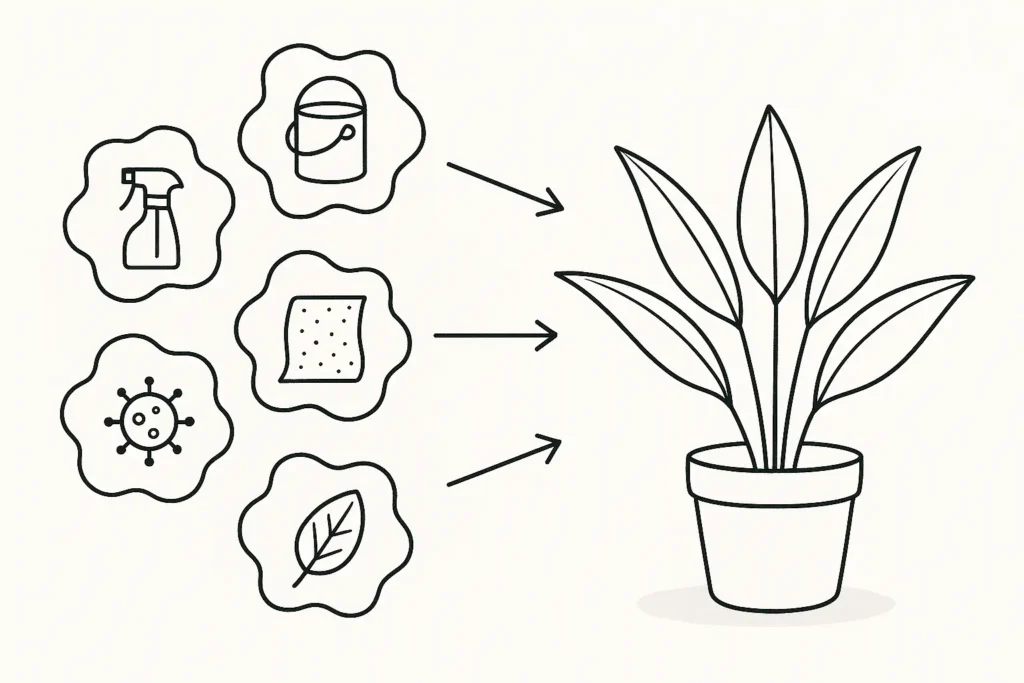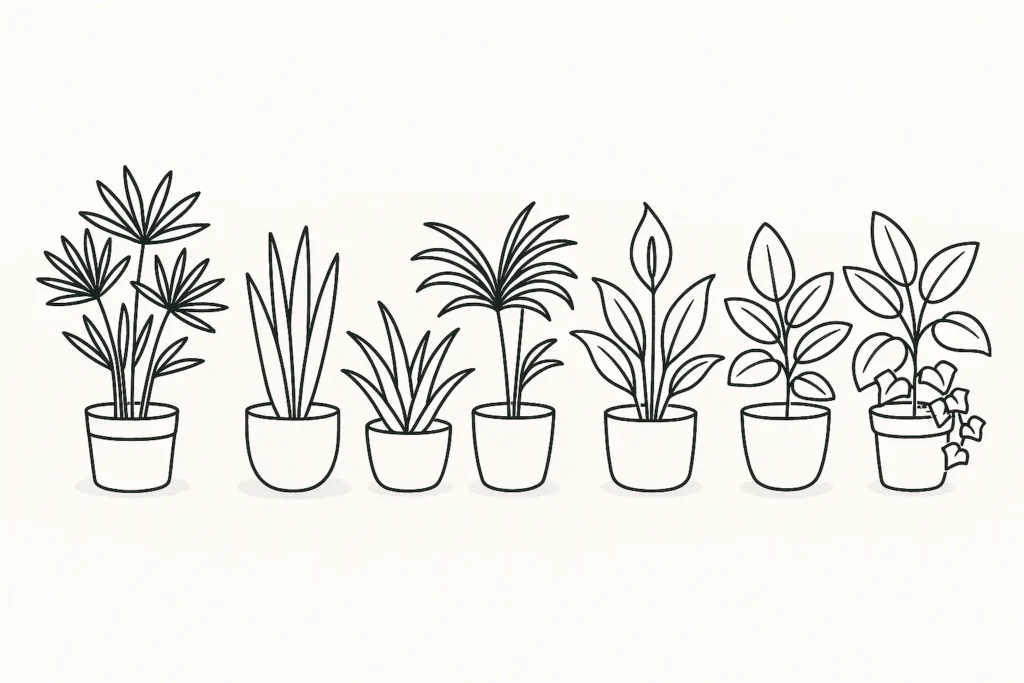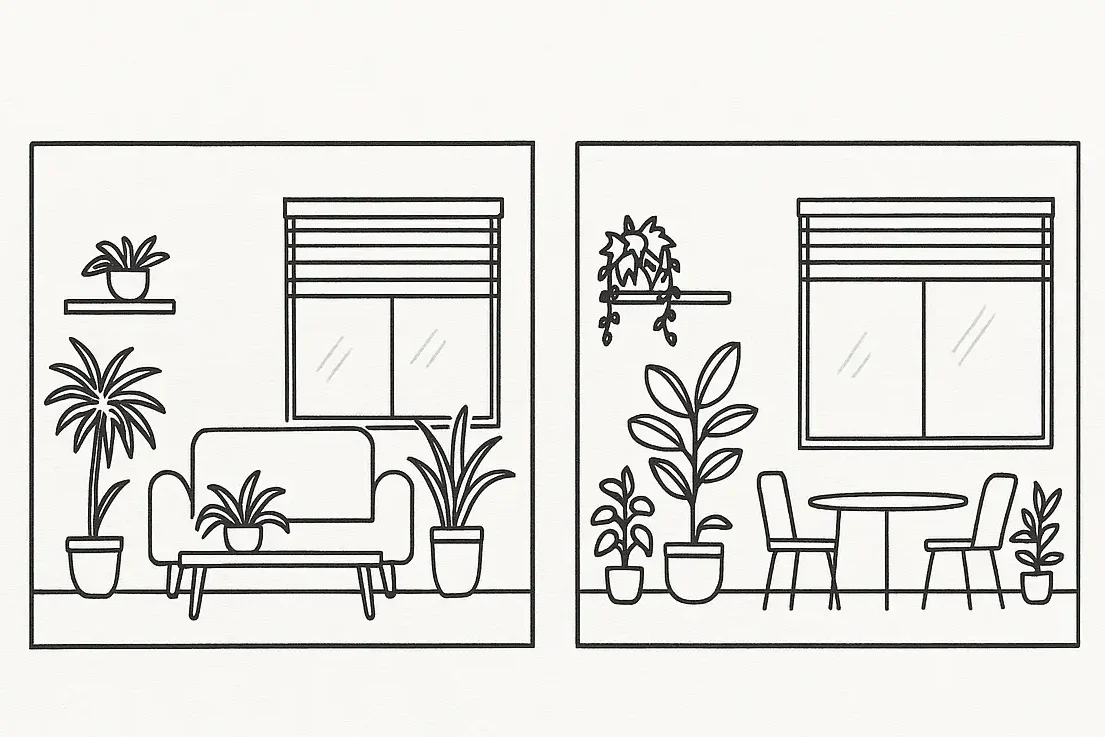Indoor air often contains small amounts of chemicals from paint, furniture, and cleaning products. Some houseplants can take in these pollutants and help improve air quality.
This article looks at how plants do this, which ones are most effective, and how many you might need in your space to make a difference.
Table of Contents
Why Choose Indoor Plants for Better Air Quality?

Indoor air often carries low levels of chemicals like formaldehyde, benzene, and xylene. These pollutants come from flooring, furniture, adhesives, and household cleaners. If a space lacks good airflow, the buildup of these compounds can lead to headaches, fatigue, or irritation.
Certain houseplants can absorb and neutralize some of these substances. This isn’t a substitute for proper ventilation, but in spaces where airflow is limited—sealed windows, shared buildings, or cold climates—plants offer an additional method of filtering indoor air.
NASA’s Clean Air Study (1989) tested various plants in sealed chambers to see how well they filtered air. While home conditions differ, that study highlighted that some species can remove specific airborne chemicals under the right circumstances.
Besides absorbing gases, many indoor plants release moisture through transpiration, which can slightly increase humidity and reduce dust movement. This makes the environment less favorable for airborne particles to circulate.
How Do Plants Remove Pollutants from the Air?
Air purification happens in several steps. When air passes over a plant’s leaves, gases like formaldehyde and benzene can enter through tiny pores called stomata. Once inside, some compounds are broken down by enzymes. Others move to the roots.
In the root zone, soil microbes break down many pollutants further. The interaction between roots and soil bacteria is a major part of the cleanup process. In some cases, the plant stores the compounds in its tissues or transforms them into less harmful forms.
Plants with broad or textured leaves also help trap airborne dust. These particles cling to the surface and can be wiped away during regular cleaning. Keeping the leaves clean helps maintain this function.
To summarize, here’s how plants contribute to air filtering:
- Leaves absorb gas-based pollutants.
- Soil microbes around the roots degrade toxic compounds.
- Roots and stems may store or convert absorbed pollutants.
- Leaves can trap dust and particles on their surfaces.
Before jumping in, you might want to check the most common gardening mistakes and how to avoid them.
The 9 Best Houseplants for Air Purifying

1. Lady Palm (Rhapis excelsa)
Lady palm is a slow-growing, upright plant known for its fan-shaped leaves and thick stems. It’s native to Southeast Asia and thrives in indoor environments with filtered light. Unlike many tropical plants, it can tolerate cooler indoor temperatures and drier air, which makes it suitable for homes and offices.
This plant is especially good at filtering out ammonia, formaldehyde, xylene, and carbon dioxide—common compounds found in cleaning products and building materials. Its broad leaves give it more surface area for gas exchange, which improves its filtering ability.
Lady palms prefer moist but not soggy soil. Overwatering can cause root rot, so it’s advised to let the top layer of soil dry slightly between waterings. Indirect light is ideal; direct sunlight may scorch the leaves.
It doesn’t release much pollen or sap, making it a good option for people sensitive to indoor allergens. Its upright structure also makes it easy to place in corners or along walls without taking up too much horizontal space.
Because it’s a slow grower, it won’t require frequent repotting. With minimal effort, it can last for many years and contribute to cleaner indoor air in a stable, low-maintenance way.
Quick facts:
- Filters ammonia, formaldehyde, xylene, and carbon dioxide
- Thrives in indirect light
- Grows slowly and stays compact
- Low allergen output
- Safe for most indoor environments
2. Snake Plant (Sansevieria)
The snake plant is one of the toughest houseplants and survives in low light, dry air, and irregular watering. Its upright, sword-like leaves are thick, waxy, and grow vertically. It stores water in its leaves, making it succulent.
This plant filters benzene, formaldehyde, trichloroethylene, and xylene. One of its notable traits is that it continues releasing oxygen at night—unlike many plants that only do so during the day. This makes it suitable for bedrooms, as it may help support better air while you sleep.
Snake plants do best in indirect light but can handle shade. They need well-drained soil and should be watered only when the soil is dry. Too much moisture is the main reason they fail indoors.
It’s also non-demanding when it comes to temperature. It tolerates indoor conditions well and even recovers from occasional neglect. Wiping its thick leaves helps remove dust and keeps its gas exchange process working.
For air filtering, its vertical structure means you can fit more plants into small spaces. It also tends to stay pest-free, which makes it a good long-term choice for indoor areas with little natural light.
Quick facts:
- Filters benzene, formaldehyde, trichloroethylene, and xylene
- Tolerates low light and dry conditions
- Releases oxygen at night
- Easy to grow and maintain
- Suitable for small spaces
3. Spider Plant (Chlorophytum comosum)
The spider plant is a popular choice for beginners. It has long, arching green leaves with white stripes and often produces small plantlets (offshoots) on hanging stems. These offshoots can be rooted and replanted easily, allowing one plant to multiply over time.
Spider plants are effective at removing carbon monoxide, formaldehyde, and xylene from the air. They also help reduce nitrogen dioxide levels. Their high transpiration rate helps increase humidity, which can slightly improve air conditions in dry rooms.
They grow well in bright, indirect light but can also tolerate lower light settings. Water when the top inch of soil feels dry—overwatering can cause the tips of the leaves to turn brown. It’s also sensitive to fluoride and chlorine, so filtered or distilled water is better if your tap water is hard.
This plant is not toxic to pets and is generally safe around children. The hanging form makes it a good option for shelves or hanging baskets, freeing up floor space. Its fast growth and low maintenance needs make it practical for covering more area with greenery and filtering.
Wiping leaves and removing dead offshoots regularly helps the plant stay healthy and function better over time.
Quick facts:
- Removes carbon monoxide, xylene, and formaldehyde
- Safe for pets and children
- Easy to propagate from plantlets
- Suitable for hanging baskets and small shelves
- Prefers indirect light and well-drained soil
4. Aloe Vera
Aloe vera is best known for its gel, which is used to soothe skin, but it’s also capable of removing formaldehyde and benzene from the air. It’s a succulent, so it holds water in its thick, fleshy leaves and prefers dry conditions.
This plant requires bright, indirect sunlight. Too little light can cause the leaves to droop, while too much direct sun may cause sunburn spots. A south- or west-facing window usually works best.
Aloe should be planted in well-draining soil—preferably a cactus or succulent mix. Water it only when the soil is completely dry. In winter, reduce watering frequency even further.
Aside from air filtration, the gel inside the leaves can be used for minor cuts or skin irritation. However, the plant itself is mildly toxic if ingested, so it should be kept out of reach of pets and small children.
Its compact size makes it good for desks, countertops, or windowsills. Dust the leaves occasionally to keep the pores clear. This helps the plant carry out gas exchange more efficiently.
While it won’t remove large amounts of pollutants, its ability to handle chemicals like benzene makes it a good small-space option with extra skin-care benefits.
Quick facts:
- Removes benzene and formaldehyde
- Needs bright, indirect light
- Water only when the soil is completely dry
- Mildly toxic if ingested
- Gel can be used for minor skin care
5. Areca Palm
Areca palm, also known as Dypsis lutescens or butterfly palm, is a tall, feathery plant that grows in clusters. It adds visual height to indoor spaces and is often used as a natural screen or room divider.
This palm removes airborne toxins such as benzene, carbon monoxide, and formaldehyde. It also releases significant moisture through transpiration, which helps raise humidity levels indoors. That’s especially useful during the winter months when heating systems dry out the air.
Areca palms like bright, filtered light. Too much direct sun can bleach the leaves, while low light can slow growth. They prefer consistently moist soil but don’t tolerate standing water. A well-draining pot with a regular watering schedule works best.
They grow quickly, so pruning dead fronds is necessary to keep the plant healthy. With proper care, the areca palm can reach 6 to 7 feet indoors. Because of its size and need for space, it works well in corners or open living areas. We have a full list of indoor garden kits that help you care for your plants.
Unlike some palms, this variety is non-toxic to pets. It does need higher humidity to thrive, so misting or placing it near a humidifier can help, especially in dry environments.
Quick facts:
- Filters formaldehyde, carbon monoxide, and benzene
- Increases indoor humidity
- Grows well in filtered sunlight
- Reaches up to 6–7 feet indoors
- Safe for pets and homes with children
6. Boston Fern (Nephrolepis exaltata)
Boston fern is a dense, bushy plant with finely divided fronds that arch outward. It’s often grown in hanging baskets or on plant stands because of its full, draping growth. This fern prefers cool, humid environments and indirect light, making it well-suited for kitchens, bathrooms, or shaded rooms with windows.
It helps filter formaldehyde and xylene—chemicals often found in furniture finishes, glue, and paints. The high transpiration rate of the Boston fern also adds moisture to the air, which can ease respiratory discomfort during dry seasons.
This plant needs consistently moist soil. It doesn’t handle drought well, and dry conditions can cause fronds to turn brown and crispy. It also prefers higher humidity; dry indoor air leads to leaf drop and poor growth. Misting or placing a humidity tray nearby can help.
Boston ferns don’t like direct sun, but too little light will make them sparse. A spot with filtered morning light is usually ideal. Regular pruning keeps the plant looking tidy and encourages new growth.
Quick facts:
- Removes formaldehyde and xylene
- Needs high humidity and consistent moisture
- Best in bright, indirect light
- Grows well in bathrooms or kitchens
- Non-toxic to pets
7. Peace Lily (Spathiphyllum ‘Mauna Loa’)
The peace lily is a tropical plant with deep green leaves and white, hooded flowers that resemble calla lilies. It’s one of the most researched air-cleaning plants and has shown strong performance in reducing airborne toxins in closed environments.
It removes benzene, formaldehyde, trichloroethylene, and ammonia. This makes it particularly useful in rooms with carpeting, painted walls, or heavy use of cleaning products. Unlike many houseplants, it also tolerates low light, though it will flower more reliably with indirect, bright light.
Peace lilies need moderately moist soil. They wilt visibly when they’re thirsty, which makes it easy to tell when to water. Letting the top inch of soil dry between waterings prevents root rot. Wipe the leaves regularly to keep pores open for air exchange.
It is mildly toxic if ingested, so it’s best kept away from pets and small children. The flowers can also produce pollen, which may irritate sensitive individuals.
Quick facts:
- Filters benzene, formaldehyde, trichloroethylene, and ammonia
- Tolerates low to medium light
- Easy to tell when it needs water (wilting leaves)
- Mildly toxic to pets and children
- Can flower indoors with proper care
8. Rubber Plant (Ficus elastica)
The rubber plant has large, glossy leaves that are excellent at trapping dust and airborne particles. It’s part of the fig family and can grow several feet tall indoors, especially with good light and care.
It’s effective at removing formaldehyde from the air—a chemical often found in wood products, carpet backing, and insulation. Its thick leaves allow for high transpiration and gas exchange when clean and healthy.
Rubber plants like bright, filtered light. They can tolerate lower light but will grow more slowly. Soil should be kept slightly moist, but never soggy. Let the top layer dry out before watering again. These plants don’t like being moved often or placed near cold drafts.
Pruning can help maintain the desired shape, especially if space is limited. Be cautious: the sap can irritate skin and is toxic if eaten, so placement matters in homes with pets or young kids.
Regularly wiping the broad leaves helps maintain their filtering ability and appearance.
Quick facts:
- Removes formaldehyde effectively
- Large leaves trap dust well
- Prefers bright, indirect light
- Can grow tall indoors (6+ feet)
- Toxic if ingested; sap can irritate skin
9. English Ivy (Hedera helix)
English ivy is a trailing or climbing vine with small, pointed leaves. It can grow in hanging baskets, trained along trellises, or left to cascade over shelves. Indoors, it stays compact and manageable with light pruning.
This plant is known for reducing airborne mold spores and filtering out benzene and formaldehyde. It has been studied for its ability to lower levels of fecal particles and airborne mold in closed environments, which may support cleaner air in bathrooms or damp areas.
English ivy prefers bright, indirect light. It does not do well in low-light conditions. Let the soil dry out slightly between waterings. Overwatering can lead to root rot, while very dry soil causes the leaves to wilt or brown at the edges.
The plant is toxic if ingested and may irritate the skin, so it should be placed where pets and children can’t reach it. It benefits from occasional misting, especially in dry rooms, and trimming encourages thicker growth.
Quick facts:
- Filters formaldehyde, benzene, and airborne mold
- Thrives in bright, indirect light
- Good for hanging baskets or shelves
- Toxic if ingested; can cause skin irritation
- Responds well to pruning for shape and density
How Many Plants Do You Need?

There’s no single number that fits every room, but research offers some guidance. The NASA Clean Air Study was conducted in sealed chambers, so results don’t directly translate to open, ventilated indoor spaces.
However, based on subsequent studies and expert assessments, here are realistic estimates for average indoor settings:
- For noticeable air filtering in a standard room (~100 square feet): Use 2–3 medium to large houseplants with broad leaves (like rubber plant or peace lily).
- In a larger space (200–300 square feet): Place 5–8 plants, ideally spread out to cover different parts of the room.
- For homes with multiple rooms, repeat placement based on room size and air movement patterns.
Variables to consider:
- Plant size: A large, mature plant filters more air than a small one.
- Leaf surface area: More leaves, or larger leaves, increase the plant’s ability to absorb and trap pollutants.
- Ventilation rate: In well-ventilated rooms, the impact of any plant is reduced. Poor airflow areas may benefit more.
- Pollutant source: If the room contains new carpet, furniture, paint, or strong chemical use, more plants may be needed.
Important: No houseplant replaces mechanical ventilation or filtration. Plants may contribute to improved conditions, but the effect is modest unless paired with other air quality strategies.
Not dramatically. They absorb some VOCs, but normal room airflow dilutes pollutants faster than plants can process them.
Larger leaves give plants more room to absorb gases and catch dust. Thick or textured leaves trap more airborne particles.
Yes, but slowly. Microbes near roots can break down certain toxins once pollutants pass through the leaves or soil.
Most plants slow gas exchange at night, but species like snake plant and aloe still absorb CO₂ after dark.
Slightly. Some plants release moisture, which can settle dust and lower the amount of dry particles floating in the air.
Yes. Several contain toxins that irritate skin or cause illness if eaten. Always check before placing plants within reach.
This content is generated by AI, reviewed by our editorial team, and features products that have been thoroughly evaluated and chosen.





